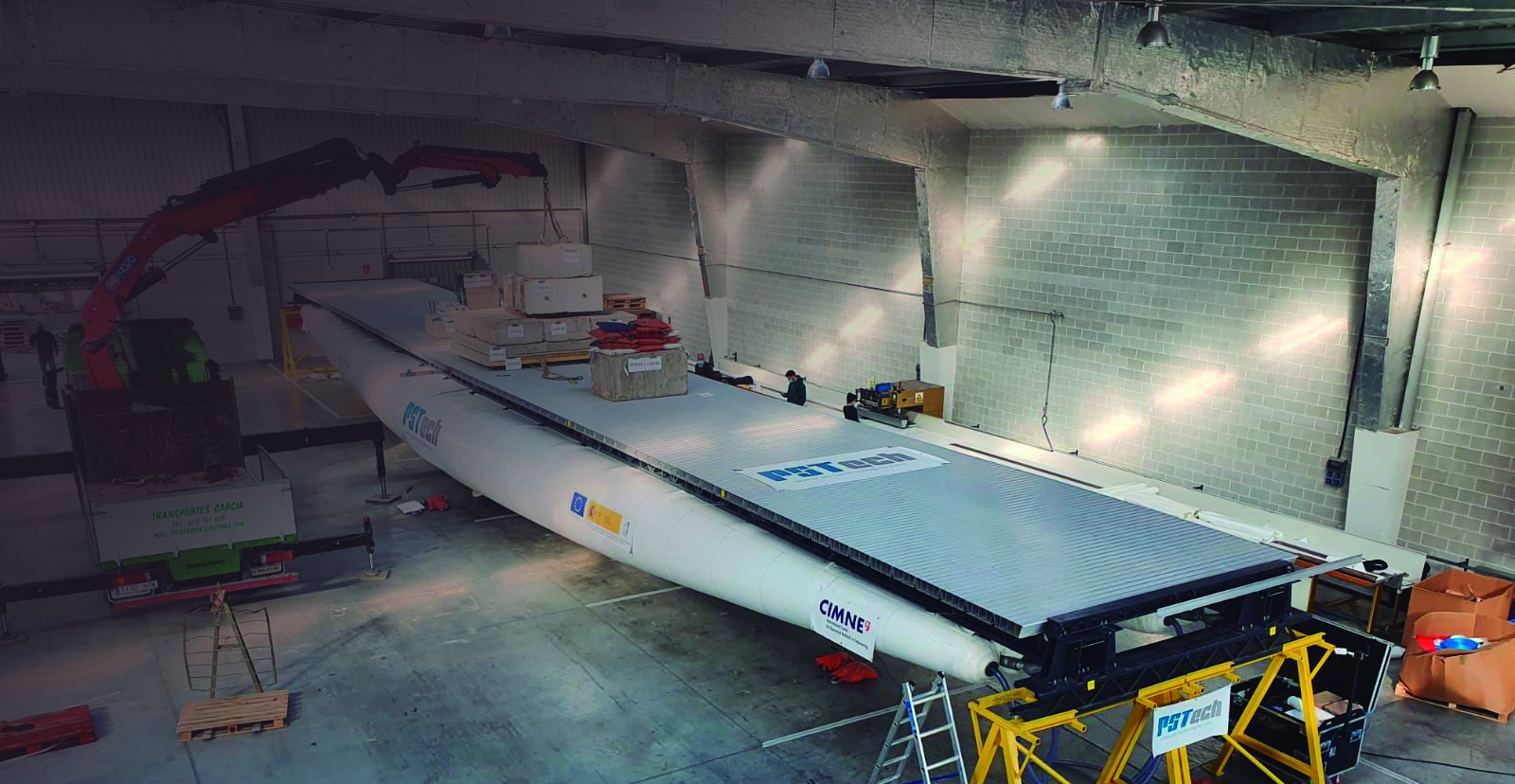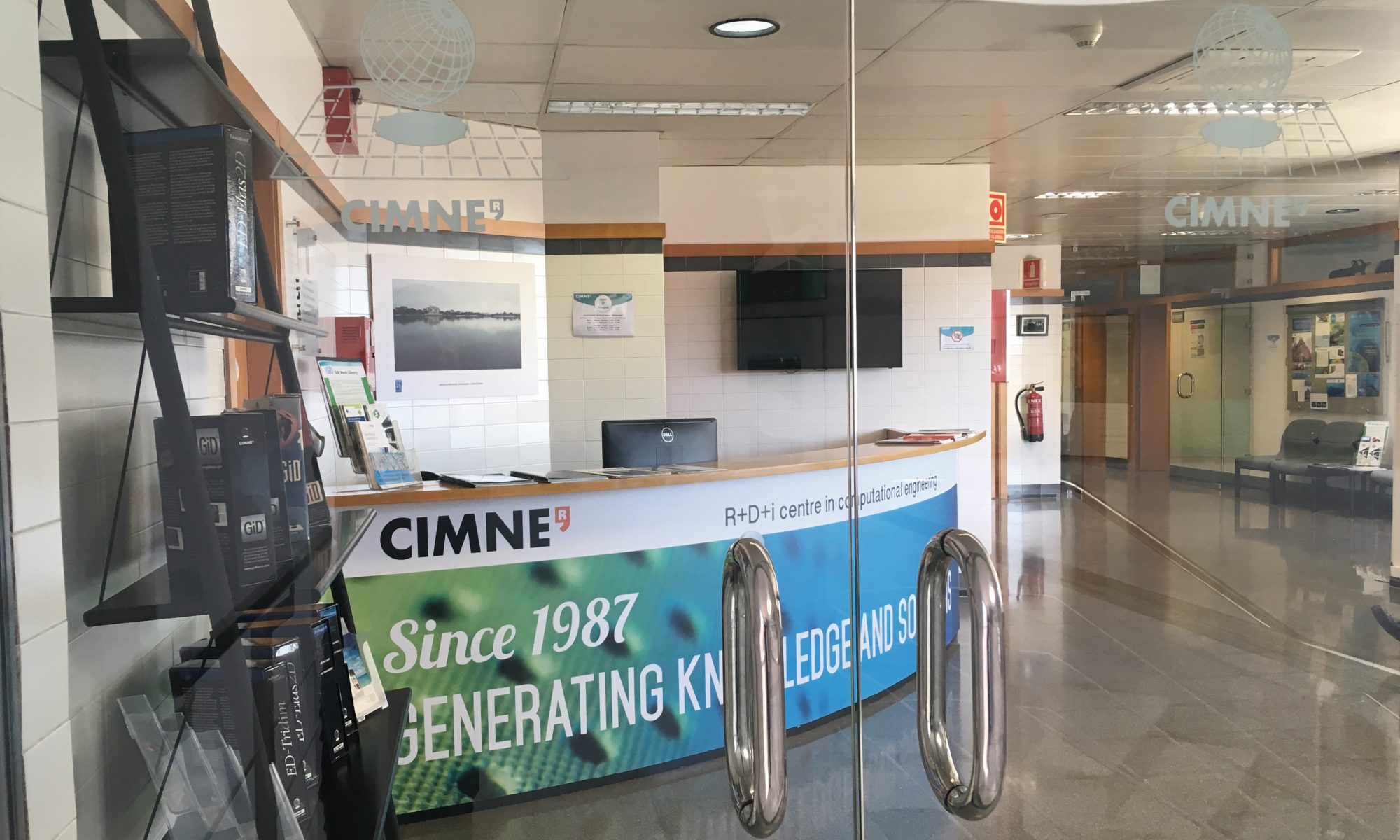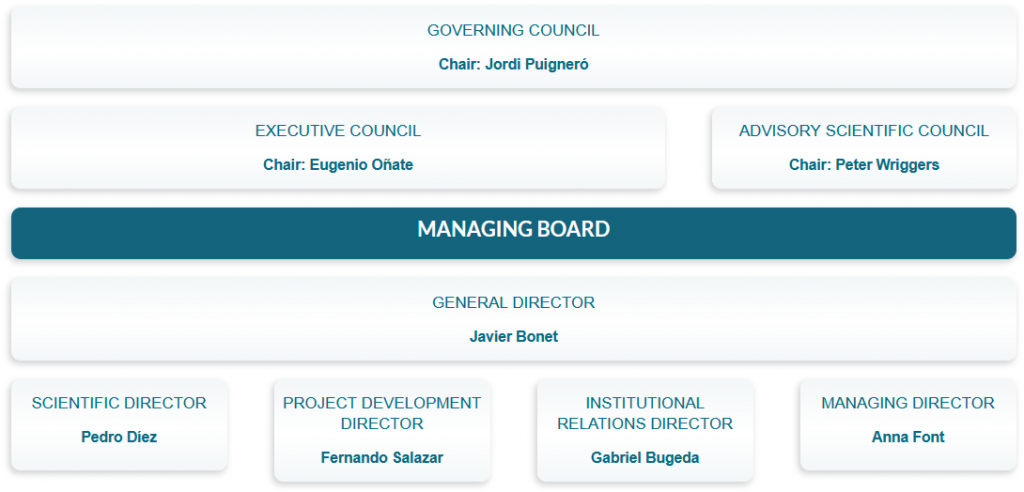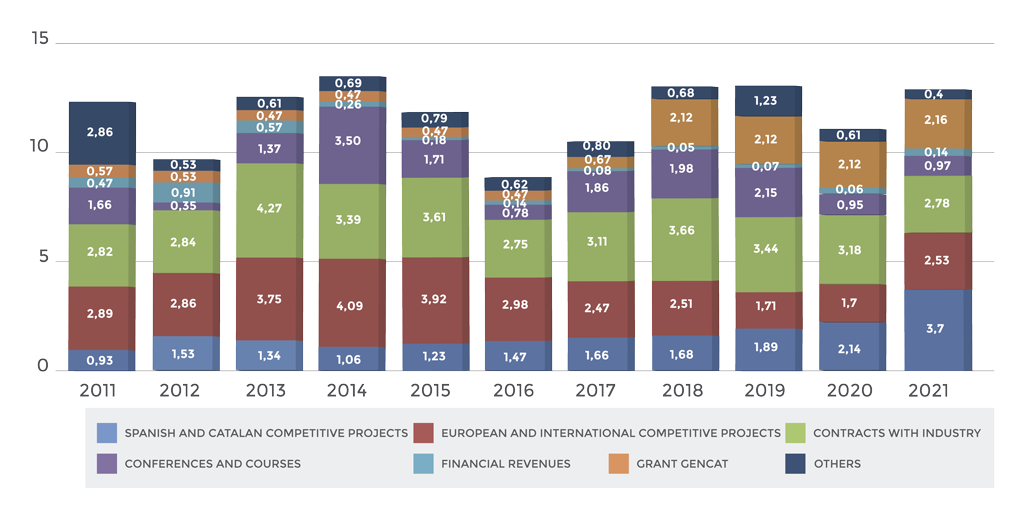The International Centre for Numerical Methods in Engineering (CIMNE) was created in April 1987. CIMNE’s mission is the development and dissemination of original research in the field of Numerical Methods in Engineering, the education of researchers and the transfer of the research outputs to industry.
CIMNE is a leader as an international centre of excellence in the field of numerical methods (NM) through four main action vectors:
- Excellence in research on NME for multidisciplinary engineering applications, in terms of scientific outputs and software-based tools.
- International dimension.
- Active participation and management in scientific societies.
- Commitment to technology transfer to industry.
Research at CIMNE focuses on the development of NM of interest to the following scientific fields: structural mechanics, geomechanics, fluid dynamics, material sciences, optimization, biomechanics coupled multi-physics processes and high-performance computing. Applications include problems in civil, mechanical, aeronautics, naval/marine, biomedical and environmental engineering, energy efficiency and fusion technology, among others.
Since 1987 CIMNE has evolved to become a prestigious international research centre on NME. Its current research staff (90% of whom are engineers) includes (by December 2021) 19 Full Research Professors, 17 Associate Research Professors, 10 Assistant Research Professors, 26 Postdocs, 11 Staff Scientists, 60 PhD Students, 72 Research Engineers and 38 Administration Staff from more than 20 countries.
Several researchers of CIMNE are faculty members of the Technical University of Catalonia (UPC) and develop their research activity in CIMNE. These distinguished affiliated researchers play an important role as liaison between researchers at different groups of UPC and CIMNE.
1987-2022: 35 YEARS GENERATING KNOWLEDGE AND SOLUTIONS IN COMPUTATIONAL ENGINEERING
In April 2022 CIMNE celebrated its 35th anniversary. During these years CIMNE has built up leadership and prestige as an international centre of excellence in the field of numerical methods in engineering.
In that period, CIMNE has carried out first class research activities in the framework of competitive international and national research programs and research contracts with industry, increased the quality and number of its scientific publications and research outputs, trained excellent researchers at PhD and postdoc levels, extended its international activities in cooperation with its network of academic and industrial partners worldwide, and implemented innovation and technology transfer activities to industry via the CIMNE spin-off companies.
COVID IMPACT
In a situation of a global pandemic, CIMNE activities have been affected. However, the centre has made a strong commitment to teleworking. A notable effort has been made to adapt work meetings, training sessions and congresses to virtual formats. The objective has been to continue advancing in a new and unexplored context.
CIMNE, CENTRE OF EXCELLENCE SEVERO OCHOA
On December 2019 CIMNE was selected as one of the “Centres for Excellence Severo Ochoa” accredited by the Spanish State Research Agency, attached to the Spanish Ministry of Science, Innovation and Universities. The Severo Ochoa Centres are selected on the basis of their excellence on scientific research and technical development activities. This important distinction includes governmental funding to hire some 35 new PhDs and 15 Postdocs for the period 2020-2023.
RESEARCH PRIORITIES AND APPLICATIONS
The priorities of CIMNE for research excellence target new NM and software to help engineers to better predict, design and optimize systems affecting our lives, including our environment, our security and safety, and the products we use.
CIMNE research in 2021 has focused in advances on NM that will have an impact on the following four broad application areas that are at the kernel of the activities of CIMNE as a Centre for Excellence Severo Ochoa: Construction and Transport, Environment, Functional Materials and Manufacturing Processes.
Some relevant problems where the NMs developed at CIMNE are applied include: structural analysis of constructions and vehicles; safety of structures to hazards; geotechnical engineering and groundwater flow; oil and gas engineering; thermal-mechanical analysis of structures and mechanical systems; industrial forming processes (sheet forming, casting, welding, additive manufacturing, machining, etc.); shape and material optimization; aerodynamics of aircrafts; blast, crashworthiness and impact problems; ship hydrodynamics; analysis of coastal and offshore structures; flow of granular materials in mining and the oil and gas industries, among other applications.
FOCUS OF CIMNE RESEARCH ON TERRITORY AND SUSTAINABILITY
CIMNE is under the auspices of the Department of Vice-presidency, Digital Policies and Territory of the Catalonian Government. This has broaden and strengthened the research activities of CIMNE on civil and environmental engineering sector by incorporating digital technologies with applications to predictive territory management, smart infrastructures, water resources, energy efficiency, digital twins for improved industrial processes, building integration modelling (BIM), transport and mobility and environmental quality and safety.
ORGANIZATION OF RESEARCH
Research in CIMNE is structured in research challenges (RChs) covering several challenging topics applicable to different engineering disciplines.
Researchers at CIMNE carry out their activity within Research and Technical Development (RTD) Groups managed by a Group Leader. The research activities are coordinated by one or more Principal Investigators (PIs). RTD Groups are gathered in RTD Areas that target fields such as Civil and Environment Engineering, Computational Materials Design and Analysis, Engineering Mechanics and Processes, Innovative Algorithms and HPC Techniques and Transport and Innovation Support and Tech Transfer.
You can visit the CIMNE RTD Areas and Groups at www.cimne.com/research
INTERNATIONAL PRESENCE
CIMNE has established 2 international branches: CIMNE Latin America and CIMNE USA and has also set up an international network of Aulas CIMNE (Joint Labs) with 30 members: 6 in Spain and 24 in Latin America; aulas.cimne.com. The International Association of Aulas CIMNE (AIAC), created by CIMNE in 2015, aims to coordinate and foster the activities on the Aulas CIMNE network.
RESEARCH OUTPUTS
In 2021 CIMNE researchers published 128 papers in JCR journals, 75,19% of the papers were published in first quartile journals. Since 1987 CIMNE researchers have published some 3,000 JCR journal papers, 46 text-books, 87 edited books, 278 monographs, 417 RTD reports, 643 technical reports and organized 255 international scientific conferences. CIMNE has 6 patents.
CIMNE scientists are chief editors or associated editors of 6 JCR journals and members of the editorial board of 15 JCR journals.
Since 1987 CIMNE researchers have taken part in 1,786 RTD projects, including 11 projects funded by the European Research Council.
In 2021, CIMNE researchers have taken part in 74 RTD projects funded by international (32 projects) and national (42 projects) organizations which have meant funding of 6,23 M€ for CIMNE. In the same period CIMNE had 132 RTD contracts with companies and private organizations amounting some 2.8 M€.
In 2021 CIMNE managed 2 international MSc courses, 2 PhD programs and organized 12 seminars and 12 CIMNE Coffee Talks. In the same year CIMNE research staff supervised 60 PhDs. 14 PhD theses were successfully completed that year.
Research at CIMNE has lead to many software codes that are useful for solving specific problems in each of the engineering areas addressed. The “CIMNE Products” section of this report lists the main software codes developed at CIMNE.
CITATION RECORDS
By March 2022, CIMNE scientists had an h index of 143 and some 95.000 citations (Source: Google Scholar). Scopus records 576 JCR papers for the period 2016-21.
Several CIMNE researchers are ranked in the first positions of the ranking for Mathematics & Interdisciplinary Applications and others of engineering created by Group for the Dissemination of the h Index (further information cimne.com/research-rankings).
By December 2021, the Ranking Web of World Research Centres (research.webometrics.info) reports that 128 CIMNE researchers the 100.000 most cited scientists of Spain best scientists in Spain in terms of citations.
MANAGEMENT OF SCIENTIFIC ORGANIZATIONS
CIMNE is the permanent Secretariat of the following scientific organizations:
• International Association for Computational Mechanics (iacm.info)
• European Community on Computational Methods in Applied Sciences (eccomas.org)
• Spanish Association for Numerical Methods in Engineering (semni.org)
• Pilot Centre of the European Research Community in Flow, Turbulence and Combustion (ercoftac.org)
• Unesco Chair on Numerical Methods in Engineering of UPC (cimne.com/unesco). This is the first UNESCO Chair in the world, created in 1989.
TECHNOLOGY TRANSFER
CIMNE has a vocation for technology transfer. Since 2001 it has launched 20 spin-off companies that market products emanating from CIMNE research. Details are given on cimne.com/spin-offs and www.cimnetecnologia.com.
AWARDS TO CIMNE AND ITS SCIENTISTS
Since 1987 CIMNE and its scientists have received some 80 awards by national and international organizations. The total list of CIMNE Awards, and those granted in 2021, can be seen on cimne.com/awards.
ORGANIZATION OF SCIENTIFIC CONFERENCES
The organization of international scientific conferences and workshops related to the research topics in CIMNE is a relevant part of CIMNE research policy.
Since 1987 the CIMNE Conference Bureau Dpt. has organized some 240 international events. In 2021, 14 international conferences organized by CIMNE were held. Some 20 international events are planned for the period 2022-2024. Details of future and past events organized by CIMNE can be found in congress.cimne.com.
RTD ALLIANCES
CIMNE is a founding partner of the FLUMEN Institute. On July 2017 CENIT (Centre for Innovation in Transport) merged its current structure into that of CIMNE, thus broadening the scope of the research activities of CIMNE in the field of transport engineering.
CIMNE has established research alliances with numerous prestigious institutions around the world.
A compilation of the most outstanding collaborations can be found in the “Alliances” section of this report.
DISSEMINATION AND COMMUNICATION STRATEGY
Dissemination and communication tasks at CIMNE involve various activities to bring the research outcomes to the attention of as many people as possible. Frequent use of social media tools are used for this purpose (Facebook, Twitter, etc). The Publications Dpt. (cimne.com/publications) of CIMNE publishes research and technical reports, monographs, text and edited books and software codes. The Aulas CIMNE network is also used for dissemination actions.
SCIPEDIA: CIMNE STRATEGY TOWARDS THE HOLISTIC 4.0 OPEN-ACCESS SCIENCE
In March 2016 CIMNE, via its spin-off company Scipedia SL, launched the innovative web platform Scipedia.com with the aim of providing free publishing and Open Access services to disseminate the results of scientific and technical work.
A SELF-SUSTAINED ORGANIZATION
CIMNE has implemented a self-sustainable financial model with limited annual public funding. This has been possible by combining public seed funding (mainly from the Catalan Government) with income from RTD projects sponsored by public and private organizations, dissemination activities, revenues from CIMNE spin-off companies and an efficient management structure. In 2021, the self-obtained income obtained by CIMNE amounted (in average) to some 85% of its total annual budget. Details of the sources of CIMNE funding in 2020 and in recent years can be found on CIMNE in numbers section.
I thank CIMNE staff and its many partners and friends. in universities, research centres and industry worldwide for their cooperation that contributes to making of CIMNE a centre of reference in its field.
Eugenio Oñate
Vicepresident of CIMNE









